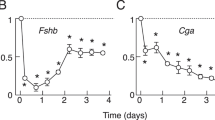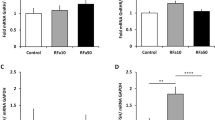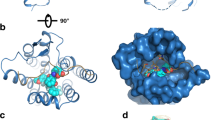Abstract
The antifertility nature of the hypothalamic peptide gonadotropin releasing hormone (GnRH) and its synthetic agonist analogue (GnRH-A) has been repeatedly demonstrated in rodents, monkeys and humans (see ref. 1 for review). In all species studied, this action of GnRH was initially attributed to ‘desensitization’ of gonadal steroidogenesis due to loss of gonadotropin receptors in the testis and ovary, induced by high circulating levels of endogenous gonadotropins achieved following repeated administration of GnRH or GnRH-A2–5. Recently, an additional, direct inhibitory action of these peptides on ovarian granulosa6,7 and luteal8–10 and testicular Leydig11–13 cells has been defined. This direct inhibition of gonadal steroidogenesis is mediated through specific high-affinity GnRH receptors in the respective target tissues8,9,12,14. These receptors exhibit identical characteristics to GnRH receptors (GnRH-R) in rodent anterior pituitary tissue9,12,14,15. In the search for a naturally occurring ligand for gonadal GnRH-R, a biologically active ‘GnRH-like’ peptide has been isolated from rat ovary16 and testis17,18, and from monkey testis interstitial fluid18. These findings suggest the production in rodent gonads of a GnRH-like peptide which, following interaction with gonadal GnRH-R, serves as a local modulator of steroidogenesis, and hence of reproductive capacity. If a similar situation exists in humans, GnRH-R should be detectable also in the human testis and ovary. We report here that we have been unable to detect any binding of radiolabelled GnRH-A to human corpus luteum or testis, or to the monkey testis. In contrast, GnRH-R were detected in adult and fetal human anterior pituitary tissue. Thus, we suggest that a direct inhibitory action of GnRH on primate reproductive function is unlikely. Furthermore, this important species difference highlights the need for a re-evaluation of certain rodent models designed to investigate primate, and especially human, reproductive physiology.
This is a preview of subscription content, access via your institution
Access options
Subscribe to this journal
Receive 51 print issues and online access
$199.00 per year
only $3.90 per issue
Buy this article
- Purchase on Springer Link
- Instant access to full article PDF
Prices may be subject to local taxes which are calculated during checkout
Similar content being viewed by others
References
Hsueh, A. J. W. & Jones, P. B. C. Endocr. Rev. 2, 437–461 (1981).
Hsueh, A. J. W., Dufau, M. L. & Catt, K. J. Proc. natn. Acad. Sci. U.S.A. 74, 592–595 (1977).
Sharpe, R. M. Nature 264, 644–646 (1976).
Conti, M., Harwood, J. P., Hsueh, A. J. W., Dufau, M. L. & Catt, K. J. J. biol. Chem. 251, 7729–7731 (1976).
Rao, M. C., Richards, J. S., Midgley, A. R. & Reichert, L. E. Endocrinology 101, 512–523 (1977).
Hsueh, A. J. W. & Erickson, G. F. Science 204, 854–855 (1979).
Hsueh, A. J. W., Wang, C. & Erickson, G. F. Endocrinology 106, 1697–1705 (1980).
Clayton, R. N., Harwood, J. P. & Catt, K. J. Nature 282, 90–93 (1979).
Harwood, J. P., Clayton, R. N. & Catt, K. J. Endocrinology 107, 407–413 (1980).
Behrman, H. R., Preston, S. L. & Hall, A. K. Endocrinology 107, 656–664 (1980).
Hsueh, A. J. W. & Erickson, G. F. Nature 281, 66–67 (1979).
Clayton, R. N., Katikineni, M., Chan, V., Dufau, M. L. & Catt, K. J. Proc. natn. Acad. Sci. U.S.A. 77, 4459–4463 (1980).
Hsueh, A. J. W., Schreiber, J. R. & Erickson, G. F. Molec. cell Endocr. 21, 43–49 (1981).
Clayton, R. N. & Catt, K. J. Endocr. Rev. 2, 186–209 (1981).
Reeves, J. J., Sequin, C., Lefebvre, F-A., Kelly, P. A. & Labrie, F. Proc. natn. Acad. Sci. U.S.A. 77, 5567–5571 (1980).
Ying, S. Y., Ling, N., Böhlen, P. & Gueillemin, R. Endocrinology 108, 1206–1215 (1981).
Sharpe, R. M. & Fraser, H. M. Nature 287, 642–643 (1980).
Sharpe, R. M., Fraser, H. M., Cooper, I. & Rommerts, F. F. G. Nature 290, 785–787 (1981).
Bourne, G. A., Regiani, S., Payne, A. H. & Marshall, J. C. J. clin. Endocr. Metab. 407–409 (1980).
Asch, R. H. et al. J. clin. Endocr. Metab. 53, 215–217 (1981).
Asch, R. H., Smith, C. G., Almirex, R. G. & Schally, A. V. 27th a. Meet. for Gynaecological Investigation, Denver, Abstr. 891 (1980).
Casper, R. F., Erickson, G. F., Rebar, R. W. & Yen, S. S. C. Fert. Steril. 37, 406–409 (1982).
Tureck, R. W., Mastroianni, L., Blasco, L. & Strauss, J. F. J. clin. Endocr. Metab. 55, 1078–1080 (1982).
Massicotte, J., Veilleux, R., Lavoie, M. & Labrie, F. Biochem. biophys. Res. Commun. 94, 1362–1366 (1980).
Hunter, M. G., Sullivan, M. H. F., Dix, C. J., Aldred, L. F. & Cooke, B. A. Molec. cell. Endocr. 27, 31–44 (1982).
Author information
Authors and Affiliations
Rights and permissions
About this article
Cite this article
Clayton, R., Huhtaniemi, I. Absence of gonadotropin-releasing hormone receptors in human gonadal tissue. Nature 299, 56–59 (1982). https://doi.org/10.1038/299056a0
Received:
Accepted:
Published:
Issue Date:
DOI: https://doi.org/10.1038/299056a0
This article is cited by
-
Treatment variables in relation to oocyte maturation: Lessons from a clinical micromanipulation-assisted in vitro fertilization program
Journal of Assisted Reproduction and Genetics (1997)
-
Effects of thymosin on the secretion of the sexual hormone in rats with experimental varicocele
Journal of Tongji Medical University (1993)
Comments
By submitting a comment you agree to abide by our Terms and Community Guidelines. If you find something abusive or that does not comply with our terms or guidelines please flag it as inappropriate.



